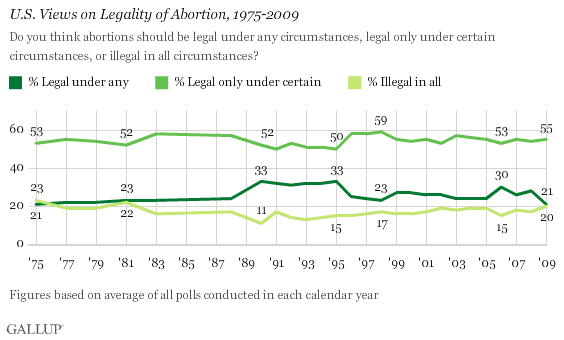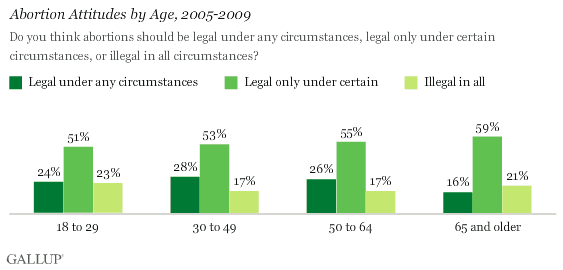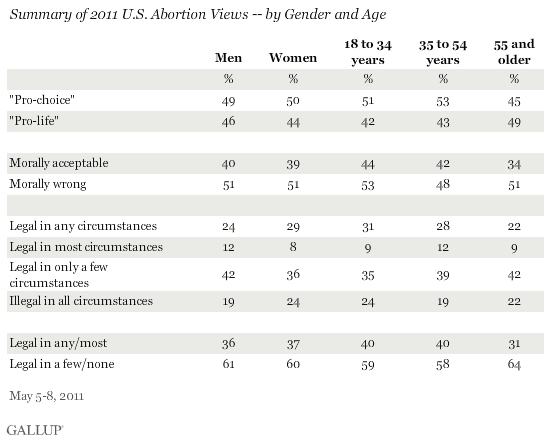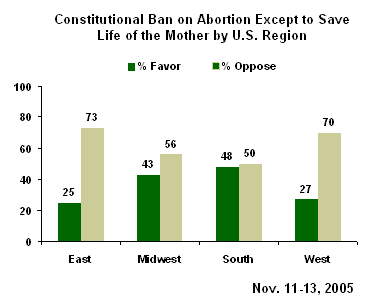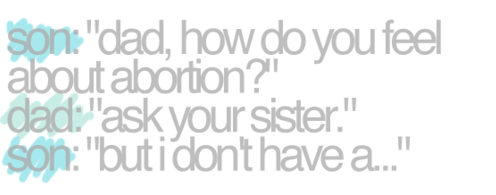 Last night, I was having some discussions about the future of the GOP (I mentioned these in my post yesterday), and I was asked whether we need to give up on abortion, moot it as an issue, and focus on less sensitive issues (like the economy) in order to win over young people, especially Ron Paul supporters. I said that we did not need to do that. In fact, I believe, it would be counter-productive; backing down on abortion abolition would not only be a grave injustice, but would actually injure us in our ground game and at the polls.
Last night, I was having some discussions about the future of the GOP (I mentioned these in my post yesterday), and I was asked whether we need to give up on abortion, moot it as an issue, and focus on less sensitive issues (like the economy) in order to win over young people, especially Ron Paul supporters. I said that we did not need to do that. In fact, I believe, it would be counter-productive; backing down on abortion abolition would not only be a grave injustice, but would actually injure us in our ground game and at the polls.
This is not conventional wisdom, and I could tell that there was more than one skeptic at the table when I said what I did. So I figured I’d better spend a little time today pulling together some data.
First, about the Ron Paul folks: Ron Paul was the most ardently pro-life candidate in the 2012 race. Rick Santorum had the reputation as the die-hard social conservative, but that was not quite true when it came to abortion. Paul signed the Personhood Pledge, authored Personhood legislation before it was cool, and put together the most innovative and promising federal abortion legislation in years. That’s why Norma McCorvey (the original “Roe” in Roe v. Wade, now a devoted pro-lifer) supported Ron Paul for President. Clearly, when it comes to Ron Paul supporters, opposing abortion is not a deal-breaker.
And this matches up neatly with my experience in “the movement.” Ron Paul supporters fell into three categories on abortion: those who were devotedly pro-life and did not want to support a “pro-life with exceptions” candidate (e.g. Romney), those who were pro-choice but did not consider it a “make-or-break” issue, and those who simply had no strong opinions on abortion. (DISCLAIMER: I was one of those pro-lifers. For more on why I backed Ron Paul, read my endorsement from last year, “Why I Support Ron Paul for President.”) If Republicans want to win Ron Paul supporters, some can be enticed with stronger positions on abortion. To be fair, though, most of those Paulites already voted for Romney (or Virgil Goode), with only a few exceptions. The rest of Paul’s supporters considered Paul’s abortion position a neutral or a negative, but those supporters are motivated by other issues, so the Republican outreach to them should begin with those issues, not with abortion.
Indeed, Paul helped awaken a division in movement libertarianism as a whole: there are some libertarians, like Gary Johnson, who see abortion as a matter of women’s liberty, and therefore support legal abortion. But there are others in the liberty movement, like Ron Paul himself, who see abortion as a matter of fetal liberty (the first, most fundamental liberty being the right not to be killed unjustly), and therefore support treating fetuses like the people they are under state and federal law. Repositioning Republicans on abortion to appeal to the pro-abortion libertarian caucus would do them few favors with the anti-abortion libertarian caucus, and would alienate traditional social conservatives (i.e. “Santorum conservatives”) to no good end.
So much for abortion and the Ron Paul kiddies. But the question I was asked was not about us Paulbots. It was about young people as a whole, and how they view abortion.
Here, we are flooded with conflicting anecdotal evidence. Certainly, the message that the Left wants you to hear is simple: Republican support for the civil rights of all persons, including the unborn, constitutes a “war on women” — and women are fighting back, with help from the pro-women, pro-equality youth movement. Republicans, the meme goes, will never win women, especially young unmarried women, until they renounce abolitionism and reduce their abortion position to expanding contraceptive access, embracing “comprehensive sex education” (i.e. putting masturbation, contraception, and deviant sexual practices in the schools), and returning their main policy energies to the economy and the budget. This is what young women in the Obama campaign say, and they are personally reinforced daily by the angry, bigoted hate machines at Jezebel and RHRealityCheck. It doesn’t hurt that their favorite stars in movies and television are all about abortion, and they make sure that the only voice young American women hear is the voice of the abortion industry.
But then you go to, say, the March for Life, and the pro-lifers couldn’t be more optimistic. I could give a few links, but the bottom line coming out of this year’s March for Life was, “Jesus Christ, where did we get all these young people?!” Even as the online youth messaging machine (where Republican ideas are barely represented) pours out the “war on women” meme, the actual youth in pro-life clubs at high schools and colleges around the country seem unfazed. Based on what I’ve seen, the war-on-women meme is just wrong.
However, I must acknowledge the possibility that my perception of young people as a whole has been skewed by the sort of young people I hang out with, who are more conservative and religious than average. Similarly, we must acknowledge that young liberal women who say that all young people agree with them on abortion also may have their perceptions skewed by their social graphs. Indeed, the effect is probably quite a bit more pronounced for young liberals, because they have almost no contact with the conservative culture that exists in parallel with theirs, whereas conservatives are immersed in liberal culture every day. (I touched on this this just yesterday.) So, instead of anecdotes, we’re going to have to resort to data.
And, with all due respect to passionate young liberal pro-aborts, the data bears me out. The meme that Republicans need to give in on abortion and endorse all the Democrats’ policies on sex and sex education is nothing but impressively self-serving propaganda. (And, man, is it ever self-serving. Go back and reread the policy menu they want conservatives to adopt on the pretext of “reducing abortions”. It’s all stuff they’ve wanted for fifty years anyway, and only now has it occurred to them to pretend it would reduce abortions.) The fact that many on the Left (and even some in the middle and on the Right) sincerely believe this silliness only shows that the Left is much more ignorant about their female and youth supporters than they think. This, incidentally, presents us with an opportunity.
First, let’s put aside all discussion of the “pro-life” and “pro-choice” labels. They are vague terms to begin with. They have become even vaguer, especially now that Planned Parenthood has abandoned the term “pro-choice.” Yes, pro-lifers celebrated last year when trends continued to show pro-life Voter ID climb, achieving an absolute majority for the first time (50%-41%) after beating out pro-choice voter ID for several years in a row. But it’s a very soft way of identifying voter behaviour, and, sure enough, this year the polls swung back, with pro-choice leading pro-life 48%-44%. Michael New took the occasion to remind us at First Things that nothing has really changed on the ground, whether in our direction or in theirs, as Americans’ self-labeling has shifted.
Second, let’s put aside all polls that simply ask whether Americans support Roe v. Wade. These polls are worse than useless. Pew recently learned that fully 4 in 10 American adults — and 6 in 10 young people! — have no idea that Roe v. Wade was about abortion. Even those (rare!) Americans who do know Roe had something to do with abortion rarely know what Roe actually did: it created (imagined) a universal constitutional right to abortion on demand, for any reason, up to the moment of birth. A number of MSM organizations that should know better regularly poll on Roe but, for reasons not understood by me, either do not mention abortion at all, or quite falsely imply (without stating outright!) that the decision only legalized abortion in the first three months of pregnancy. So most of these Roe polls tell us more about whether young people support school desegregation (I’m not joking! Read the Pew poll!) than about what abortion policies young people support.
Instead, let’s look past labels and dive into policy. Polling on abortion policy has been surprisingly consistent since Roe, with measurable but modest gains for pro-lifers since 1992:
About 20% of the public wants to outlaw abortion in all cases, even when the mother’s life is physically threatened. About 25% of the public wants abortion to be legal in all cases, up to (and including!) the moment of birth. And about 55% of the public wants abortion to be illegal in some cases. For some in that huge 55% bloc, that means banning all abortions except those directly necessary to save the mother’s life, as in an ectopic pregnancy. For others, it means allowing all abortions except those in the third trimester (or about 95% of them). Women are more polarized on abortion than men, but, contrary to the “war on women” meme, they are not polarized in favor of abortion; they are simply more likely to take an extreme position, and the extreme anti-abortion position is about as likely as the extreme pro-abortion one.
That’s the big picture. What about young people?
Young people have single-handedly saved the pro-life movement from slipping away into the background. As the Greatest Generation died off, they left behind a world of Boomers and Gen X’ers, who are far more supportive of abortion rights in general and in particular than their elders were. This should have caused abortion to become more popular — its opponents were literally dying off! And, indeed, until 1992, that’s exactly what happened (see above graph). But, starting in 1992, abortion support peaked and began to decline back toward its baseline. Although there was some erosion for abortion support across all age groups as the partial-birth abortion debate overtook Congress, it did not seem to account for the entire decline. Then, starting in the year 2000, the General Social Survey began registering something very interesting: young people aged 18-29 were more anti-abortion than their parents. I see no reason to repeat Michael New’s findings, so I won’t.
By 2009, Gallup was forced to acknowledge it was seeing the same thing:
This holds true when we go a bit further and subdivide “certain circumstances” and into “most” circumstances and “a few” circumstances. (Note the inclusion of 29-34 year olds makes this sample of “young people” somewhat more pro-abortion than the last one.)
As we can see, young people are not just leaning toward the “everything-but-partial-birth” end of the spectrum. To an even greater degree than the middle-aged, those young people who support legal abortion in “some circumstances” lean heavily toward restrictions.
Bottom line: the current generation of young people is the most anti-abortion generation in half a century.
Some might say, “Well, okay, but pro-choice young people, even if they are a minority, are a lot more active, and therefore a lot more useful, than young pro-lifers.” However, the data do not bear out that claim. On the contrary, anti-abortion voters are significantly more likely to make their decision based on a candidate’s abortion position than are pro-aborts, netting Abolitionist candidates and their allies anywhere from 2 to 7 points in a presidential election year (or a 4 to 14 point swing). NARAL agrees — and goes farther, finding in its internal polls that young people who oppose abortion are dramatically more likely to consider it an important issue than young people who support it… by a margin of more than 2-to-1! Alienating those anti-abortion activist voters is dangerous: when a candidate (like Mr. Romney) fails to live up to the pro-life ideals of much of his base, even as an opposing candidate (like Mr. Obama) aggressively panders to the pro-choicers in his, the result is that those intense pro-life voters stay home, while the intense pro-choicers come out. I argued last November that that was a surprisingly significant factor in our electoral defeat (although I need to take another look at that article, now that all votes have been counted).
In summary, abortion opposition is becoming more politically palatable as young people grow up, not less. This is the only social issue I can think of where this is true. The opposite is happening on marriage, and I am not sanguine about its electoral prospects — nor our party’s, as long as we maintain our present course on marriage. (More on this at a later date.) We would do ourselves a serious electoral disservice, however, by addressing both issues identically in our policy or our messaging. Among older voters, it seems like they run together a little bit — “abortion’n’gaymarriage” — and behaviour on one almost perfectly predicts behaviour on the others. Among young people, that’s not true, and we are increasingly seeing young’uns rise up who are anti-abortion and pro-gay marriage. Young people are deciding in increasing numbers that you can be both.
How do we exploit their openness to us on abortion? Well, we keep right on doing what we’ve been doing! There is overwhelming support for most of the “incrementalist” pro-life measures we’ve been trying to pass since Planned Parenthood v. Casey, and we can continue passing such measures indefinitely. Arkansas just banned abortions after 12 weeks (i.e. the first trimester), which, if this Marist poll or this Polling Company poll or this Gallup poll are any indication, is just about where Americans think the line should be drawn right now. There’s a lot we can do to get there, too, as long as we’re careful not to present anything that can be ripped away from us an misrepresented in the media as “forced transvaginal ultrasounds” or whatnot. The popular wind is at our back, policy-wise. It’s messaging where we seem to fall down.
Meanwhile (speaking of messaging), there is overwhelming opposition to the Democrats’ official platform position that any pregnant mother, of any age, should be able to kill that child at any time, for any reason, without limitation, restriction, or discouragement, on the public dime. Somehow, we Republicans, who encompass a variety of pro-life positions on abortion (from Bill Glahn’s restrict-but-not-too-much to President Bush’s just-for-rape-and-incest to my own nope-let’s-just-abolish), allowed ourselves to be treated last election cycle as though we were nothing but a gang of ignorant Todd Akins, when our Democratic opponents are far more extreme, far more outside the American mainstream, and far more uniformly doctrinaire on the issue than we are. We can and should expose that. The trick is doing so in a positive way that attracts voters.
Finally, in states where it is sustainable, we should continue advancing toward the goal posts. Midwestern and Southern states appear ready, in some cases, to embrace the new civil rights movement all the way:
…and, sure enough, debates over Personhood amendments are making serious headway in Georgia, Mississippi, and North Dakota. These are to be encouraged, partly because it is the right thing to do, but partly because, once a state passes Personhood and the sky doesn’t fall (as Planned Parenthood insists it will), the Republican position will become more attractive to everyone in the country.
There are also Personhood efforts underway in several states where they have no chance of passing, such as Washington and Colorado. These should not be encouraged, since they are a waste of resources if they fail, and they alienate electorates that are not yet ready to support them. But those same measures also should not be discouraged, except perhaps on the sly, since discouraging them only focuses the attention of our enemies on the finer points of Republican abortion policy, leads to ugly internal fights, as happened in Wisconsin last year, and gives Planned Parenthood an opening to pour good solid lies into the electorate without serious opposition, which helps nobody on the right-wing at all. (Disclaimer: I made an extensive argument in favor of Wisconsin’s Personhood proposal last year, taking sides in one of those ugly internal fights. I believed it had a reasonable chance at passing, if adequately defended before the voters.)
But Minnesota is a long way from being capable of that kind of amendment. I’m not even sure the room I was in last night would have backed Personhood. For now, I would focus our ire on extremism in the Minnesota abortion lobby. Doe v. Gomez, a 1995 Minnesota Supreme Court decision, has held for almost twenty years that the Minnesota Constitution requires us to provide free abortions, for any reason, at any stage of pregnancy, through Medicare. I don’t there’s ever been a poll that supports that, anywhere in the country. We can fight that, and we can win it.
But now I have digressed considerably from the questions I was asked: Does abortion hurt us among Ron Paul supporters? Among young people as a whole? The answer, fairly definitively, is “No” to both questions. Republican anti-abortion policy does not harm us, and actually helps us (modestly) in both those cohorts. We should continue with our existing policies, revise our messaging to frame abortion as a “human rights” issue (winner) instead of a “public morality” issue (loser), and we should even find ways to advance our ultimate agenda of abolition in those states the popular will is behind it.
Republican anti-abortion messaging, on the other hand, can and does hurt us. But that’s another blog post.

